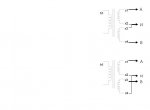Dismissing the facts because the answers are not in a format you like is not a strong argument. ...
YES - I wish really you would stop doing that - it's very annoying.
... Our industry presents a different view than what you present. You are not going to find support for the idea that a 180? displacement is "in phase". I'm not sure what definition you are looking for, but keep in mind that the people writing the textbooks and teaching the classes are not just pulling the idea of a 180? displacement being out-of-phase out of thin air. They have a basis for that consistent presentation and the entire industry seems to use the same basis.
Our industry does not support the idea that a 180? displacement is somehow considered "in phase".
Here are some more examples to add to the ones I gave you before (I added highlights):
I’m aware the authors didn’t pull their “180? displacement” concepts out of the air. I’m also aware the original use of the term
“single-phase” as it applies to electrical phenomena predates anything even remotely like oscilloscopes by at least five years.
However, I do sincerely appreciate your efforts to offer proper definitions - you have done as I asked, thank you.
Although I'm sure you would like to, since ambiguity and "bait & switch" are some of your favorite tactics, we can't use all of the various definitions interchangeably. Pick one and only one of the definitions you propose to apply to the topic
"Why is residential wiring known as single phase?” If we both agree to it, then a proper stipulation has been developed
between us; i.e., no one else is obligated to accept it. Otherwise it’s just arguing to argue and we can both go home - each confident that we "won" the argument.
I'm sorry but you don't get to assert
yours or any branch of the industry’s
colloquialisms is mandatory for everyone - yet (That’s an improper “stipulation.”) But possibly in the future.
I would remind you that examples themselves are not definitions; at best, they are descriptions.
Edit Add: My boss actually expects production from me occasionally, so I may not be able to respond quickly. It's one of the reasons I usually limit myself to hazardous locations; it doesn't take too much of my time.

